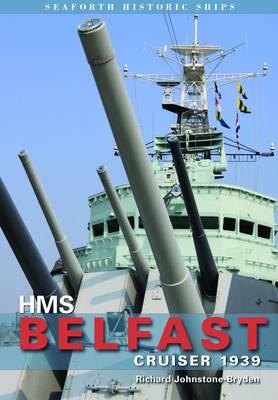
The 4th volume in Seaforth Publishing’s acclaimed Historic Ships series is devoted to the rich heritage of the UK’s biggest preserved ship, HMS Belfast. Completed on the eve of WWII, the light cruiser’s action packed naval career included the capture of the German liner Cap Norte, the Battle of North Cape, the D-Day Landings, the Yangtse Incident, and the Korean War.
Belfast’s story began with the laying of her keel on 10 December 1936 as one of the two 613ft Edinburgh class cruisers which boasted a standard displacement of 11,550 tons, a main armament of twelve 6inch guns and a top speed of 32 knots. Belfast was launched on St Patrick’s Day 17 March 1938 and commissioned on 5 August 1939. Belfast’s patrol between Iceland and the Faroes at the beginning of WWII culminated in the capture of the SS Cap Norte on 9 October 1939. The liner was disguised as a neutral ship and trying to smuggle reservists back to Germany. Six weeks later, a magnetic mine broke Belfast’s back in the Firth of Forth.
Belfast was assigned to protect the Arctic convoys when she rejoined the Fleet three years later. The perilous voyages to resupply the Soviet forces, that were fighting the Nazis on the Eastern Front, were described by Winston Churchill as, “the worst journey in the world.” Belfast’s 761 men endured temperatures as low as minus 30ºC as the cruiser ploughed through the icy waters, in addition to facing the threat of attacks by submarines, aircraft and surface raiders. Amid these arduous duties Belfast participated in the Battle of North Cape on Boxing Day 1943 which culminated in the destruction of the German battlecruiser Scharnhorst.
Six months later, Belfast’s main armament opened fire on German positions in support of the Normandy D-Day landings on 6 June 1944. Belfast continued to bombard German forces for five weeks until she sailed for the Tyne to be refitted for the Pacific Fleet. The war had concluded before Belfast reached Australia, so on arrival she participated in the repatriation of Allied prisoners of war.
After WWII, Belfast was mainly stationed in the Far East and played a key, yet distant role in the Yangtze incident, which occurred in April 1949 when Chinese Communists attacked and blockaded HMS Amethyst, while heading up the Yangtze River. The sloop’s subsequent breakout was planned and overseen 500 miles away in the Admiral’s quarters in Belfast.
A year later, Belfast fired her guns in anger again while participating in the Korean War as part of the UN operations in support of South Korea. During this conflict Belfast spent 404 days on patrol, steamed over 97,000 miles and bombarded enemy positions with 8000 6inch rounds – more than she had fired throughout WWII. In 1959, Belfast emerged from an extensive refit in Devonport Dockyard, which included the fitting of an enclosed bridge and two lattice masts. After two Far East commissions followed by eight months in the Home Fleet, Belfast paid off into reserve on 25 February 1963 which appeared to conclude her sea-going career. However, there was to be a brief swan song thanks to The Admiral Commanding Reserves, Rear Admiral H C Martell CB CBE, who instigated Belfast’s final six week commission under the command of Captain H C J Shand DSC RN. This final voyage enabled 300 Sea Cadets to particpate within a unique training cruise to Gibraltar.
Belfast paid off into reserve following her return to Devonport on 24 August 1963. A four man team from the Imperial War Museum (IWM) instigated the cruiser’s preservation in the Pool of London. Although their scheme was vetoed by the Government, it provided the groundwork for the HMS Belfast Trust’s successful bid which culminated in Belfast’s opening to the public in October 1971. By December 1975, 1,500,000 visitors had explored the ship, yet there were still concerns about her long term future. Reassured by the Trust’s success, the Government approved the IWM’s acquisition of the cruiser in 1978.
Belfast continues to attract approximately 250,000 visitors every year and serves as a lasting reminder of the powerful, big-gun armoured warships that formed the backbone of the Royal Navy during the first half of the 20th Century. The cruiser also provides visiors with a superb insight into a period of remarkable technological and social change in the Royal Navy from the 1930s to the 1960s.
The wholehearted support of the preservation team’s staff and volunteers enabled Richard to take an extensive series of colour images of the Ship’s exterior and internal compartments, including a number of areas that are closed to the public. A significant proportion of the book is devoted to these images which take the reader on a unique illustrated tour of the Ship from bow to stern and deck-by-deck, thereby creating the most comprehensive visual record and explanation of the ship that exists.
Product Details
Title: HMS Belfast Cruiser 1939
Edition: 1st
Publisher: Seaforth Publishing
Format: Soft Back
Publication Date: 30 June 2013
ISBN 978-1-84832-155-7
Number of Published Pages: 128
Number of Images:
RRP £14.99
Remarks: In print – available direct from Seaforth Publishing, on board HMS Belfast and in all good bookshops (both online and on a high street near you).